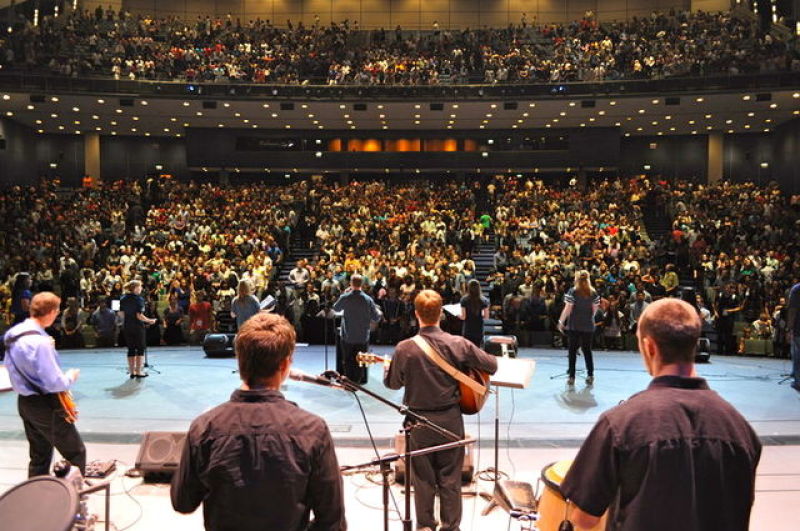
Centers for Disease Control and Prevention(CDC) drafted guidelines for restaurants, schools, churches and businesses so the institutions can safely reopen as states look to lift their coronavirus restrictions gradually.
"Interim Guidance for Communities of Faith" is specially composed for the congregations and places of worship (churches, synagogues, mosques, temples, etc.), voluntary social service agencies and other nonprofit organizations, and community organizations. This guidance is intended to help these organizations prevent the transmission of COVID-19 within their facilities and communities.
The draft guidance from the Centers for Disease Control and Prevention has been sent to Washington but still could be revised before being released to the public. This means that these guidelines are not legally binding and has not been officially released yet. State and local officials will be the ones to adopt and enforce them. CDC states, "guidance is not intended to infringe on First Amendment rights as provided in the US Constitution."
"The federal government may not prescribe standards for interactions of faith communities in houses of worship and no faith community should be asked to adopt any mitigation strategies that are more stringent than the mitigation strategies asked of similarly situated entities or activities in accordance with the Religious Freedom and Restoration Act (RFRA)."
The CDC suggests the following instructions for consideration "to the extent consistent with each community's faith tradition"
Safety Actions
Promote healthy hygiene practices
- Encourage use of a cloth face covering at all gatherings and when in the building by everyone except children aged less than 2 years old.
- Have adequate supplies to support healthy hygiene behaviors, including soap, hand sanitizer with at least 60 percent alcohol (for staff and older children who can safely use hand sanitizer), tissues, and no-touch trash cans
- Consider posting signs on how to stop the spread of COVID-19 and promote everyday protective measures, such as washing hands and covering coughs and sneezes and properly wearing a face covering.
Intensify cleaning, disinfection, and ventilation
- Clean and disinfect frequently touched surfaces at least daily and shared objects between use.
- Avoid use of items that are not easily cleaned, sanitized, or disinfected.
- Ensure safe and correct application of disinfectants and keep them away from children.
- Ensure that ventilation systems operate properly and increase circulation of outdoor air as much as possible by opening windows and doors, using fans, etc. Do not open windows and doors if they pose a safety risk to children using the facility.
- Take steps to ensure that all water systems and features (for example, drinking fountains, decorative fountains) are safe to use after a prolonged facility shutdown to minimize the risk of Legionnaires' disease and other diseases associated with water.
Promote social distancing
- Limit the size of gatherings in accordance with the guidance and directives of state and local authorities and in accordance with RFRA.
- Consider video streaming or drive-in options for services.
- If appropriate and possible, add additional services to weekly schedules to maintain social distancing at each service, ensuring that clergy, staff, and volunteers at the services ensure social distancing to lessen their risk.
- Consider holding services and gatherings in a large, well-ventilated area or outdoors, as circumstances and faith traditions allow.
- Space out seating for attendees who do not live in the same household to at least six feet apart when possible; consider limiting seating to alternate rows.
- Consider whether other gatherings may need to have attendance limited or be held virtually if social distancing is difficult, such as funerals, weddings, religious education classes, youth events, support groups and any other programming.
- Avoid or consider suspending use of a choir or musical ensemble during religious services or other programming, if appropriate within the faith tradition. Consider having a soloist or strictly limiting the number of choir members and keep at least six feet between individuals.
- Consider having clergy hold virtual visits (by phone or online) instead of in homes or at the hospital except for certain compassionate care situations, such as end of life.
Limit community sharing of worship materials and other items
- Consider temporarily limiting the sharing of frequently touched objects, such as worship aids, prayer books, hymnals, religious texts and other bulletins, books or other items passed or shared among congregants, and encourage congregants to bring their own, if possible, photocopying, or projecting prayers, songs, and texts using electronic means.
- Modify the methods used to receive financial contributions. Consider a stationary collection box, the mail, or electronic methods of collecting regular financial contributions instead of shared collection trays or baskets.
- Consider mitigating the risk of transmitting COVID-19 posed by close physical contact among members of the faith community during religious rituals as well as mediated contact through frequently touched objects, consistent with the community's faith traditions and in consultation with local health officials as needed. o If food is offered at any event, have pre-packaged boxes or bags for each attendee whenever possible, instead of a buffet or family-style meal.
- Avoid food offerings when it is being shared from common dishes.
Monitoring and Preparing
Check for signs and symptoms
- Encourage staff or congregants who are sick to stay at home.
Plan for when a staff member or congregant becomes sick
- Identify an area to separate anyone who exhibits COVID-like symptoms during hours of operation and ensure that children are not left without adult supervision. o Establish procedures for safely transporting anyone who becomes sick at the facility to their home or a healthcare facility.
- Notify local health officials if a person diagnosed with COVID-19 has been in the facility and communicate with staff and congregants about potential exposure while maintaining confidentiality as required by the Americans with Disabilities Act (ADA) or other applicable laws an in accordance with religious practices.
- Inform those with exposure to a person diagnosed with COVID-19 to stay home and self-monitor for symptoms and follow CDC guidance if symptoms develop.
- Close off areas used by the sick person and do not use the area until it after cleaning and disinfection; wait 24 hours to clean and disinfect to reduce risk to individuals cleaning. If it is not possible to wait 24 hours, wait as long as possible before cleaning and disinfecting. Ensure safe and correct application of disinfectants and keep disinfectant products away from children.
- Advise sick staff and congregants not to return to the facility until they have met CDC's criteria to discontinue home isolation.
Maintain healthy operations
- Implement flexible sick leave and related flexible policies and practices for staff (e.g., allow work from home, if feasible).
Monitor absenteeism and create a roster of trained back-up staff. Designate a staff person to be responsible for responding to COVID-19 concerns. Employees should know who this person is and how to contact them. - Communicate clearly with staff and congregants about actions being taken to protect their health.
Closing
- Check state and local health department notices daily about transmission in the community and adjust operations accordingly.
- In the event a person diagnosed with COVID-19 is determined to have been in the building and poses a risk to the community, it is strongly suggested to close, then properly clean and disinfect the area and the building where the individual was present



















